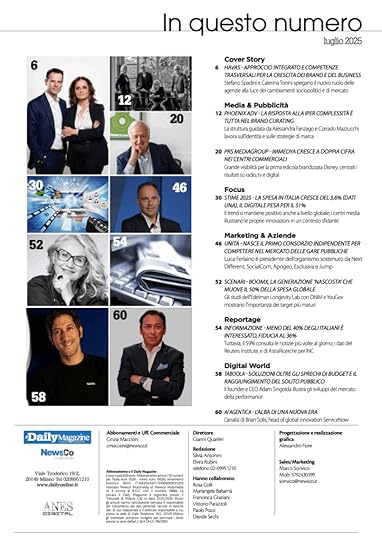Brian Solis's Blog, page 5
July 9, 2025
Daily Magazine Italia: Scenari Intelligenza artificiale e AI agentica, l’alba di una nuova era
L’alba di una nuova era, l’analisi di Brian Solis, head of global innovation ServiceNow (Page 60)

Screenshot
The post Daily Magazine Italia: Scenari Intelligenza artificiale e AI agentica, l’alba di una nuova era appeared first on Brian Solis.
July 5, 2025
CIO España: La IA supone un cambio de paradigma al exigir a las organizaciones que se replanteen la forma de operar
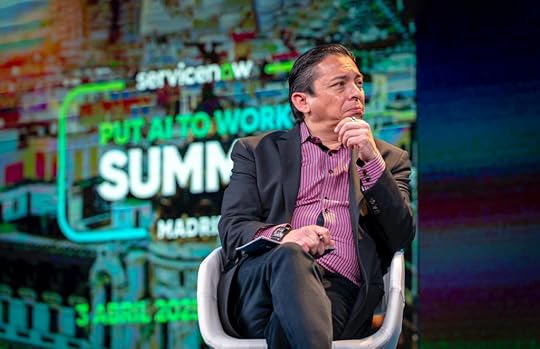
Por Irene Iglesias Álvarez, CIO España, El antropólogo digital y futurista ahonda en el porvenir de los negocios en un escenario copado por la inteligencia artificial e insta a los CIO a tomar la delantera. Así ha hablado para esta publicación.
Presentado en sociedad como antropólogo digital y futurista, el perfil de Brian Solis bien podría considerarse una rara avis dada su singularidad; sin embargo, en un escenario en el que parecen brotar evangelistas por doquier al abrigo de la digitalización, su figura también podría haberles pasado desapercibida. Precisamente por eso, aprovechando su parada en la capital en el marco de la celebración del evento Put AI to Work Summit 2025 de ServiceNow, CIO ESPAÑA se sentó el pasado mes de abril con el orador de renombre mundial para tomar el pulso a la tecnología que más clamores parece estar levantando en los últimos tiempos: la inteligencia artificial (IA).
El ejecutivo habla con razón de causa, parece sentar cátedra en una conversación que domina con agudeza. Y es que la experiencia es un grado, algo que queda patente al conocer su labor al frente de la compañía de desarrollo de software: el asesoramiento a líderes tecnológicos y empresariales a lo largo y ancho de la geografía sobre estrategias de innovación y transformación digital. Por si esto no fuera un trabajo a tiempo completo, Solis también atesora un palmarés de publicaciones que versan sobre el futuro de los negocios, el trabajo, la digitalización y la innovación en sectores como el comercio minorista, la salud, los servicios financieros, los seguros y el sector público.
Sus trabajos y presentaciones humanizan las tendencias y tecnologías disruptivas y su impacto en las empresas, los mercados y las sociedades. “Hacemos la investigación necesaria para luego aplicar ingeniería inversa o backcasting con el propósito de ayudar a nuestros clientes a tomar decisiones a largo plazo sobre la transformación digital”, explica.
¿Cómo ve el panorama tecnológico actual? ¿Qué impacto diría que tienen las tecnologías emergentes en la sociedad, la industria y la empresa en la actualidad?
El impacto de la tecnología es increíble y maravilloso, pero es mayor de lo que, creo, a la mayoría de las personas les está dando tiempo a comprender. Si pensamos en cada revolución tecnológica de las últimas décadas, las organizaciones las han incorporado tradicionalmente para hacer mejor lo que hacían ayer, y los objetivos han sido la escala, la eficiencia, la optimización, tal vez el aumento de la rentabilidad, todas cosas buenas. Sin embargo, cuando la IA generativa llegó al mercado en 2022, se produjo la misma reacción. Pero ésta, como saben, requiere de datos óptimos para que las organizaciones puedan explotar los conocimientos y las capacidades de la IA.
Esto es importante, anuncia un cambio de paradigma porque, finalmente, hay una tecnología que exige a las organizaciones que se replanteen su forma de operar. Lo que tenemos delante es una oportunidad para que las organizaciones no solo miren a la IA, sino que miren a cada evolución que esta trae consigo, como la IA agentiva, para hacer de su empresa una organización más inteligente. En lugar de adaptar el trabajo del pasado, podemos reinventarlo para el futuro.
Este es el momento más importante no solo para reaccionar, sino también para pensar en estrategias futuras. Hay estudios interesantes que muestran cómo la gente en general se siente abrumada por la tecnología en sus vidas, sienten que pueden no tener el control de la tecnología tanto como la tecnología tiene el control de ellos. Por ejemplo, con las redes sociales, los dispositivos móviles, la IA que potencialmente reemplaza puestos de trabajo… Sin embargo, al mismo tiempo, existe una oportunidad de oro para que las empresas y la sociedad se transformen. Es el momento de que la tecnología trabaje para nosotros.
La inteligencia artificial está de moda, es un hecho incontestable. ¿Cree que su potencial para transformar está a la altura del hype que genera o viviremos un invierno de la IA?
Todas las tecnologías pasan por un ciclo de exageración, como ha radiografiado Gartner, y ciertamente la IA ha alcanzado el pico, pero es de esperar que todas las tecnologías acaben encontrando sus casos de uso para la transformación. Por ejemplo, cuando hablamos de cómo las empresas utilizan las tecnologías para hacer que el mañana sea mejor que el ayer, ahí es donde se ha centrado la IA generativa. Ayuda a la gente a escribir mejores correos electrónicos, mejores presentaciones. Ayuda a los usuarios a obtener un mejor servicio de atención al cliente en términos de autoayuda, pero esa, esa es la historia de la automatización.
Para que cualquier tecnología alcance su verdadero potencial se necesita visión, y la visión es un bien preciado. La visión requiere que alguien entienda el potencial de un caso de uso que no existía ayer para transformar el mañana. Aquí es donde la innovación se vuelve tan poderosa, especialmente con la IA. Creo que se abre un horizonte de maravillosas oportunidades que harán que las personas sean más capaces mañana de lo que eran ayer. Esto significa que la visión requiere definir cuáles serán las habilidades laborales del futuro. El potencial futuro está en la colaboración con la IA, los nuevos resultados que se pueden lograr a través del equilibrio entre el ser humano y la IA. Esta sintonía entre la automatización y la mejora permitirá a las personas, ya sean profesionales en el trabajo o en su vida personal, lograr los tipos de resultados que ayer no eran posibles o que ni siquiera se concebían. Aquí es donde el potencial del que hemos oído hablar con la IA pasará de ser una exageración a una realidad.
Hoy en día todas las empresas tienen una gran oportunidad para inclinarse hacia la innovación. La forma en que defino la innovación es creando nuevo valor. Muchas empresas confunden innovación con iteración, ¿vale? Por ejemplo, ahora estoy usando IA, somos innovadores, pero si nos fijamos en cómo la están aplicando, en realidad es iterativa. La innovación sería el equivalente a hacer algo completamente nuevo para crear nuevo valor. Y creo que estamos pasando del hype a la visión con la IA para crear un futuro que antes no era posible.
“Para que cualquier tecnología alcance su verdadero potencial se necesita visión, y la visión es un bien preciado. Requiere que alguien entienda el potencial de un caso de uso que no existía ayer para transformar el mañana”
¿Cuál es su consejo para los CIO que no quieran quedarse atrapados en la automatización, es decir, que busquen pasar de la iteración a la aumentación y a la innovación?
El futuro para los directores de sistemas de la información pasa potencialmente por añadir innovación a la visión y estrategia empresarial. Este es un momento realmente poderoso para que se desafíen a sí mismos mientras piensan en sus propios roles. El consejo que tengo para los CIO es que adopten lo que llamamos una mentalidad AI first, una filosofía de innovación, que desafíen todas sus convicciones.
Entiendo que los directores de sistemas de información tienen una presión tremenda, más tecnología que nunca, así como tanta tecnología heredada que impide una transformación rápida. Pero si alguna vez hubo un momento para considerar un nuevo futuro, es ahora.
El consejo que tengo para los CIO es que se pregunten qué papel quieren desempeñar en la transformación empresarial de la IA. Porque, históricamente, los directores de sistemas de información se han considerado un centro de costes. Y cuando se te considera un centro de costes, a menudo tus principales métricas son: ¿cuánto coste puedes sacar de la organización?, ¿dónde podemos ahorrar dinero?, ¿dónde podemos optimizar?, ¿dónde podemos racionalizar?, ¿dónde podemos automatizar todas las conversaciones importantes que tenemos? Pero creo que el futuro de los CIO tiene que virar hacia preguntas tales como: ¿cuál es el crecimiento que puedo impulsar a través de las inversiones? ¿Cómo cambio mi narrativa dentro de la organización para no pensar solo en los costes, sino también en impulsar un crecimiento que ayude a nuestra organización a competir en una era de IA a través de la automatización y la mejora?
Se trata de un conjunto diferente de preguntas que abren nuevas oportunidades para la organización, que desbloquean el potencial de la automatización y la aumentación para lograr el crecimiento, lo que creo que transformará el papel de los CIO en roles más influyentes dentro de la empresa a la hora de definir cuál podría ser el futuro de los negocios.

¿Va a cambiar esto la narrativa entre el CIO y los comités de dirección?
Eso espero. Creo que este es un destino que los CIO deben crear para sí mismos. Está en su mano definir cómo se presenta ante la alta dirección y los consejos de administración para defender las inversiones en la transformación de la IA a nivel empresarial, más allá de un simple nivel de transformación heredado. Es un momento muy importante para ellos.
Cambiando de tercio, la IA agentiva parece haberse convertido en la hermana popular de la IA generativa, ¿por qué? ¿Cómo diría que están revolucionando la operativa y la estructura de las organizaciones?
Uno de los retos a los que se enfrentan las organizaciones es que cuando buscan reducir únicamente costes utilizando la IA, comunicar el retorno de la inversión es muy difícil, por lo que las organizaciones se encuentran todavía madurando la forma de implementarla. El pasado mes de mayo publicamos un informe llamado AI Index, que estudiaba el nivel de madurez que tenían las empresas a medida que iban implementando la IA y, en última instancia, transformándose. Tenemos una última versión del estudio que sostiene que las empresas están en una fase muy temprana de madurez. Están en pañales en cuestiones como la gobernanza, la definición de casos de uso, la puesta a prueba de esos casos de uso, la demostración de valor y, por tanto, el potencial de esa transformación.
No obstante, hay que considerar inversiones paralelas y beneficios rápidos como la reducción de costes o los flujos de trabajo interfuncionales que transformarán la organización para ahorrar y escalar aún más, pero también para obtener mejores resultados. Este va a ser un caso de uso diferenciado porque va a liberar a las personas, aumentar la productividad y permitirnos definir los roles futuros ahora mismo. Con un enfoque aumentado, con una mentalidad centrada en la IA, las empresas podrán definir un nuevo valor neto y resultados diferenciados que les ayudarán a desplegar un nuevo abanico de oportunidades.
“El futuro para los directores de sistemas de la información pasa potencialmente por añadir innovación a la visión y estrategia empresarial”
Si a las empresas no les fue del todo bien desplegando pruebas de concepto de IA generativa, ¿qué le hace pensar que tendrán mejor suerte con la IA agentiva? ¿Qué grado de adopción podemos esperar?
Esta es una pregunta importante, realmente creo que es un reflejo de muchas de las diferencias que hemos discutido entre iteración e innovación. Si nos fijamos en investigaciones de Gartner e IDC, se muestra que las empresas no han logrado los tipos de resultados que pensaban que eran posibles con la transformación digital. Se podría decir, por tanto, que estamos viendo los mismos retos con la IA generativa al aplicar la misma mentalidad. En este sentido desafiaría a los CIO y a los demás directivos a trabajar juntos. Tenemos que soñar a lo grande para que la IA logre los tipos de resultados que esperan los comités de dirección en términos de negocio, productividad y competitividad.
El CIO, para cambiar su discurso, tiene que centrarse en los casos de uso que le van a permitir ir un paso más allá, hacer que el negocio sea más eficiente y más eficaz. Así que digo: sueñen a lo grande con los casos de uso que consideren y defiendan su valor más allá de los rápidos beneficios iniciales que las empresas buscan.
Con el punto de mira puesto en el futuro próximo, ¿qué debemos esperar? ¿Qué tendencias marcarán el compás de la innovación redefiniendo el mundo como hasta ahora lo habíamos imaginado?
¿Hacia dónde se dirigirá el futuro en los próximos 10 años? Creo que veremos empresas basadas en IA agentiva poniendo en marcha flujos de trabajo increíblemente eficientes y efectivos, los datos finalmente comenzarán a llegar al core para dar vida a una inteligencia dentro de la organización de formas que no existían antes… Todo esto hay que imaginarlo, por eso es tan importante, especialmente para los CIO, tomar la delantera. Y es que a menudo hablamos del futuro como si fuera algo que está en el horizonte, pero está aquí mismo. Los agentes de IA ya están aquí; y si vamos a generar un mayor retorno de la inversión, si vamos a generar un trabajo transformador, si vamos a impulsar el futuro de los roles para que los empleados prosperen en una era de IA aumentada, este es el momento en el que nosotros, como líderes, tenemos que dar un paso adelante.
The post CIO España: La IA supone un cambio de paradigma al exigir a las organizaciones que se replanteen la forma de operar appeared first on Brian Solis.
July 4, 2025
El Periódico: La IA se está comiendo el mundo: la nueva revolución empresarial ya está aquí

Al automatizar procesos repetitivos, la inteligencia artificial permite que los equipos se enfoquen en lo que aporta valor: la creatividad, la estrategia y la resolución de problemas
Hace una década, fue el ‘software’. Según la célebre frase de Marc Andreessen, esta tecnología se estaba «comiendo el mundo» y cambiaría nuestras vidas para siempre.
Ahora, con la Inteligencia Artificial (IA), llega otra revolución. No es solo un avance tecnológico, sino el inicio de una nueva era en la que las empresas pueden desafiar lo establecido, reinventar la manera en que crean valor y transformar su futuro de la mano de clientes y empleados.
En un mundo donde la disrupción marca el ritmo, la IA se ha convertido en un homogeneizador que brinda a todas las organizaciones la oportunidad de romper barreras y liderar la innovación. Imaginemos una pyme que, gracias a esta tecnología, puede ofrecer recomendaciones personalizadas con la misma precisión que los gigantes del comercio electrónico. O un centro médico que utiliza la IA para mejorar diagnósticos y ofrecer tratamientos más eficaces, transformando la atención a sus pacientes. Son solo algunos ejemplos de cómo la inteligencia artificial está nivelando el terreno de juego, democratizando la innovación y abriendo oportunidades antes inimaginables para que todas las empresas, independientemente de su tamaño, crezcan y sean más ágiles.
Lo extraordinario de esta revolución es el poder transformador de la IA para revelar un nuevo valor, que permite a las organizaciones evolucionar de lo rutinario a lo estratégico, de lo reactivo a lo predictivo, y de productos estándar a experiencias personalizadas y escalables, abriendo un mundo de posibilidades sin igual.
La experiencia del cliente es un claro ejemplo. En la era hiperconectada, la personalización ya no es un lujo, sino una ventaja competitiva. Gracias a la IA, las compañías pueden procesar enormes volúmenes de datos en tiempo real para ofrecer experiencias hiperrelevantes a gran escala. Un caso emblemático es Netflix: su motor de recomendaciones no solo mantiene a los usuarios enganchados, sino que también impulsa la producción de contenido y refuerza la fidelización.
La inteligencia artificial personaliza experiencias y, al mismo tiempo, libera a las personas de tareas repetitivas. Al automatizar procesos como la entrada de datos, la gestión de inventarios o la logística, permite que los equipos se enfoquen en lo que realmente aporta valor: la creatividad, la estrategia y la resolución de problemas. No se trata de sustituir empleos, sino de potenciarlos, otorgando más autonomía a los profesionales para asumir desafíos mayores y mejorar la experiencia tanto de empleados como de clientes. No es casualidad que los líderes empresariales destaquen su potencial transformador. Como apunta Bill McDermott, quienes no adopten la IA a tiempo corren el riesgo de quedarse atrás, perdiendo la oportunidad de dar un salto exponencial hacia el futuro.
La IA impulsa la innovación, un pilar clave para prosperar en un entorno marcado por la disrupción y la competencia. Innovar no es solo generar ideas, sino explorarlas, probarlas y perfeccionarlas. Gracias a herramientas basadas en la IA generativa, las empresas pueden conceptualizar, hacer prototipos e iterar a una velocidad que parecía imposible hace una década, acelerando la creación de productos realmente innovadores.
Aquí radica el verdadero desafío (y la oportunidad), en no confundir la innovación con la iteración. La distinción es crucial: la iteración perfecciona lo existente, mientras que la innovación genera un valor completamente nuevo. En la inteligencia artificial, la automatización corresponde a la iteración. En cambio, la verdadera innovación surge de la sinergia: la capacidad de que humanos y máquinas trabajen en conjunto para alcanzar resultados más complejos, con un valor exponencial en comparación con lo que una entidad por sí sola podría lograr.
En 1983, Steve Jobs predijo que el ordenador se convertiría en el principal medio de comunicación, transformando la relación entre humanos y tecnología. Aunque al principio el PC seguía siendo una herramienta limitada, comparable a los primeros televisores que solo replicaban programación de radio, Jobs anticipó que pronto empoderaría a los usuarios, permitiendo crear contenido. De manera similar a la ‘sinergia’ de hoy, Jobs vislumbró una nueva era en la que la tecnología no solo mejoraría lo existente, sino que abriría nuevas posibilidades.
Lo mismo ocurre en la actualidad con la IA. Todavía la utilizamos como las tecnologías anteriores, automatizando tareas digitalizadas en lugar de replantearnos cómo trabajamos. Es una “mentalidad de control de gastos”, que considera la IA solo como una herramienta para reducir costes, en lugar de reconocerla como un motor de crecimiento exponencial.
Su verdadera innovación, en cambio, va más allá de automatizar tareas; implica adoptar un pensamiento lateral y redefinir la forma de trabajar. Aquí es donde entra el agente de IA: no solo ejecuta tareas, sino que aprende, se adapta y toma decisiones estratégicas de manera autónoma. Al optimizar procesos y sistemas en tiempo real, abre nuevas posibilidades para transformar la manera de operar y tomar decisiones.
Esto cambia por completo las reglas del juego, permitiendo a las organizaciones aumentar la creatividad, adaptarse de manera dinámica a mercados cambiantes y liberar el potencial humano como nunca antes.
Siguiendo la comparación de Steve Jobs entre los nuevos medios y los anteriores, el agente de IA transformará la automatización de flujos de trabajo derivados de la digitalización de procesos tradicionales. Esto permitirá repensar cómo hacer las cosas, creando flujos innovadores impulsados por la IA. En resumen, no se trata solo de ser más eficientes, sino de aprender a reinventar.
La inteligencia artificial ya no es una opción; cambiará nuestras vidas como lo hicieron internet y el móvil. Ahora, la pregunta que cada empresa debería hacerse es si su enfoque está en la innovación o solo en la iteración. Solo aquellas que adopten la IA con curiosidad, valentía y el compromiso de explorar lo desconocido prosperarán; las otras quedarán atrás.
Vivimos una transformación en la que ya no basta con reaccionar. Es necesario un cambio de mentalidad para liderar con audacia e innovar sin miedo. La IA está transformando el mundo, ofreciendónos oportunidades inéditas.
Esta tecnología es el futuro, y ese futuro ya está aquí. Es hora de redefinir las reglas de la innovación, y no podemos esperar. La inteligencia artificial ha llegado para quedarse y solo quienes aprovechen su poder liderarán una nueva era de posibilidades.
The post El Periódico: La IA se está comiendo el mundo: la nueva revolución empresarial ya está aquí appeared first on Brian Solis.
July 2, 2025
Industria Italiana: L’IA agentica è un’opportunità che non si può rischiare di perdere. Parola di ServiceNow

Riceviamo e pubblichiamo integralmente un articolo a cura di Brian Solis, head of global innovation di ServiceNow, Industria Italiana
La rivoluzione dell’intelligenza artificiale non è solo un altro capitolo della storia della tecnologia, ma l’inizio di una storia completamente nuova. Una storia in cui le aziende possono reimmaginare ciò che è possibile, ripensare la creazione di valore per un mercato in evoluzione e rimodellare il proprio futuro insieme a clienti e dipendenti.
In un mondo in cui la disruption sembra essere diventata la norma, l’IA è un grande equalizzatore. Immaginate un piccolo rivenditore che sfrutta l’IA per offrire suggerimenti personalizzati alla pari dei giganti dell’e-commerce o un fornitore di servizi sanitari che utilizza l’IA per migliorare gli esiti dei pazienti con una diagnostica di precisione. L’IA sta livellando il campo di gioco, democratizzando l’innovazione, sbloccando possibilità prima irraggiungibili e spalancando le porte della crescita e dell’agilità.
L’era di un nuovo valore
Ciò che rende questa rivoluzione così straordinaria è la capacità dell’AI di aiutare i leader con una mentalità creativa e aperta a scoprire un valore che non sapevamo nemmeno esistesse. Permette di passare dal banale al rilevante, dalla reattività alla predittività, dalla staticità alla dinamicità, da prodotti uguali per tutti a esperienze profondamente personali e scalabili.
Pensiamo per un attimo alla customer experience. Nel mondo iperconnesso di oggi, la personalizzazione non è solo un qualcosa di piacevole, ma è un vantaggio competitivo. L’intelligenza artificiale è in grado di elaborare enormi quantità di dati sui clienti in tempo reale, consentendo alle aziende di offrire esperienze iper-rilevanti su scala. Il motore di suggerimenti di Netflix, per esempio, è la colonna portante della produzione di contenuti e della fidelizzazione dei clienti.
Allo stesso tempo, l’AI può liberarci dalle attività più ripetitive. Automatizzando le attività più banali, come l’inserimento dei dati, la gestione dell’inventario, la logistica, consente alle persone di concentrarsi su ciò che conta davvero: creatività, strategia e risoluzione dei problemi. Non si tratta di sostituire i posti di lavoro, ma di elevarli. I team sono in grado di affrontare sfide più importanti, che portano a dipendenti e clienti più impegnati e soddisfatti.
Alla conquista dell’innovazione
Bill McDermott, presidente e ceo di ServiceNow, ha recentemente affermato che “l’AI è la più grande opportunità del nostro tempo”. Le aziende più lente e avverse al rischio che adottano un approccio attendista nei confronti dell’AI danno ai concorrenti non solo un vantaggio, ma una vera e propria possibilità di sorpasso.
“I ritardatari e i negazionisti in materia di AI subiranno un’enorme perdita”, ha avvertito McDermott.
L’intelligenza artificiale potenzia l’innovazione, che è fondamentale per affrontare un mercato e una concorrenza in continua trasformazione. Ogni innovazione inizia con l’esplorazione e la sperimentazione. Grazie a strumenti come l’IA generativa, le aziende possono concettualizzare, prototipare e testare e iterare a una velocità che un decennio fa si poteva solo sognare. Immaginiamo di sviluppare prodotti che non si pensava fossero possibili o che non si potevano concepire.
Ma ecco la sfida e anche l’opportunità: molte aziende confondono l’iterazione con l’innovazione. Qual è la differenza? L’iterazione migliora qualcosa di esistente. L’innovazione crea un nuovo valore netto. In un mondo di IA, l’automazione è l’equivalente dell’iterazione. Qual è la correlazione con l’innovazione? Per quanto riguarda l’IA, è augmentation, la capacità di umani e macchine di collaborare per ottenere risultati più grandi ed esponenziali di quelli possibili da parte di una sola entità.
Nel 1983, Steve Jobs aveva previsto che i personal computer sarebbero diventati onnipresenti e sarebbero diventati il principale mezzo di comunicazione. Predisse anche che all’inizio avremmo “sbagliato modo di usare i computer”, paragonandoli alla prima generazione di televisori che fornivano contenuti visivi che all’epoca erano essenzialmente programmi radiofonici ripresi da una telecamera. “Quando un nuovo mezzo di comunicazione entra in scena, tendiamo a farlo rientrare nelle vecchie abitudini”, ha spiegato.
Ha poi parlato di tutte le capacità che un personal computer avrebbe sbloccato, trasformando gli utenti di computer di tutti i giorni in artisti e trasformando le comunicazioni lungo il percorso. Lo stesso vale per l’IA.
Oggi usiamo questo nuovo strumento nel nostro lavoro nello stesso modo in cui abbiamo utilizzato lo strumento di ieri. Stiamo ancora automatizzando il lavoro di ieri che abbiamo digitalizzato negli sforzi di “trasformazione digitale” di ieri, invece di reimmaginare il lavoro per ciascun mezzo. Le aziende sono in gran parte bloccate nella “mentalità del centro di costo”, utilizzando l’AI per tagliare le spese invece di investire in aree che possono generare un valore esponenziale.
La vera innovazione richiede un cambiamento di mentalità. Si tratta di aprire la mente, concedersi il permesso di essere più curiosi e creativi, mettere in discussione le ipotesi e chiedersi non solo come fare le cose in modo migliore o meno costoso, ma anche come farle in modo diverso.
L’ascesa dell’AI agentica
È qui che la situazione si fa davvero entusiasmante: la nascita dell’IA agentica. L’IA agentica apprende, si adatta e agisce in modo autonomo. Questi agenti non si limitano a eseguire compiti, ma orchestrano sistemi complessi, lavorano insieme, ottimizzano i processi in tempo reale e prendono persino decisioni strategiche… e imparano da queste decisioni per migliorare il processo decisionale.
Perché questo è positivo per le imprese? Perché cambia radicalmente le regole di ingaggio. L’IA agentica permette alle organizzazioni di scalare la creatività, di adattarsi dinamicamente ai mercati in evoluzione e di liberare il potenziale umano in modi mai visti prima.
Immaginate gli agenti dell’AI che gestiscono le catene di approvvigionamento, ottimizzano i viaggi dei clienti o addirittura guidano l’innovazione esplorando le idee, il tutto coinvolgendo un essere umano, ma muovendosi più velocemente e su scala.
Rivediamo il rapporto tra iterazione, innovazione e automazione e il paragone di Steve Jobs tra un nuovo mezzo e il mezzo precedente. L’ascesa dell’IA agentica può, e molto probabilmente lo farà, collocare gli agenti all’interno di workflow automatizzati che sono stati digitalizzati da predecessori analogici. Allo stesso tempo, gli innovatori riconsidereranno il lavoro stesso per immaginare nuovi workflow verso risultati iterativi e innovativi che l’IA e l’IA agentica catalizzano.
Non si tratta più solo di efficientare, ma di reinventare.
Abbracciare l’inevitabilità e conquistare le possibilità dell’IA
L’IA non è un optional. È inevitabile come lo era Internet e come lo sono stati la telefonia mobile e i social media. L’unica domanda da porsi è se la si abbraccerà con la mentalità dell’iterazione o con quella dell’iterazione + innovazione. Le aziende che si avvicinano all’IA con curiosità, coraggio e impegno nell’esplorare l’ignoto prospereranno rispetto a quelle che, come ha descritto Steve Jobs, usano il nuovo strumento come utilizzavano il precedente.
L’IA è il futuro, e quel futuro si sta dispiegando ora. La rivoluzione dell’IA non sta solo bussando alla porta, ma invita a riscrivere le regole. Questo è il momento. Non bisogna aspettare che sia qualcun altro ad aprire la strada, perché è probabile che questo porti dritti verso l’iterazione. È il momento di essere leader di cui hanno bisogno i clienti, i dipendenti e la propria azienda. L’intelligenza artificiale è qui per restare e per coloro che sono pronti a sfruttare la potenza dell’automazione e dell’augmentation, il futuro è esponenziale.
The post Industria Italiana: L’IA agentica è un’opportunità che non si può rischiare di perdere. Parola di ServiceNow appeared first on Brian Solis.
June 27, 2025
CIO: Is declining AI maturity a sign of progress?

Dave Wright, Rachael Sandel, Brian Solis
via CIO Online, Dave Wright and Brian Solis
At first glance, the central finding in the newly released ServiceNow and Oxford Economics’ 2025 Enterprise AI Maturity Index study seems surprising: on a 100-point scale, the average AI maturity score dropped nine points from last year. With so much attention, focus and investment in AI, how is it possible that businesses have fallen behind?
The reasons are relatable but telling. The speed of AI is overwhelming and moving faster than most organizations can keep up. In 2022, OpenAI introduced the world to generative AI. By 2024-2025, AI agents took over the spotlight. Now, agentic AI is the new rage. At the same time, AI complexity combined with the uncertainty around unproven pilots and the inherent limitations of basic use cases is holding back companies around the world, and across every industry. Naturally, they’re more reserved and move cautiously.
There are also those leaders who see uncertainty as a catalyst for finding answers and an opportunity for curiosity, exploration and imagination. This group is motivated to speed up, to challenge their assumptions and explore bolder, more ambitious pilots that move the needle. In doing so, they broaden their perspectives and force-function the ability to uncover more impactful AI use cases and outcomes. ServiceNow calls these progressive leaders AI Pacesetters.
AAt first glance, the central finding in the newly released ServiceNow and Oxford Economics’ 2025 Enterprise AI Maturity Index study seems surprising: on a 100-point scale, the average AI maturity score dropped nine points from last year. With so much attention, focus and investment in AI, how is it possible that businesses have fallen behind?
The reasons are relatable but telling. The speed of AI is overwhelming and moving faster than most organizations can keep up. In 2022, OpenAI introduced the world to generative AI. By 2024-2025, AI agents took over the spotlight. Now, agentic AI is the new rage. At the same time, AI complexity combined with the uncertainty around unproven pilots and the inherent limitations of basic use cases is holding back companies around the world, and across every industry. Naturally, they’re more reserved and move cautiously.
There are also those leaders who see uncertainty as a catalyst for finding answers and an opportunity for curiosity, exploration and imagination. This group is motivated to speed up, to challenge their assumptions and explore bolder, more ambitious pilots that move the needle. In doing so, they broaden their perspectives and force-function the ability to uncover more impactful AI use cases and outcomes. ServiceNow calls these progressive leaders AI Pacesetters.
What does it mean to be low or high in AI maturity?
The study measured organizations across five pillars of maturity:
AI strategy and leadershipWorkflow integrationTalent and workforceAI governanceRealizing value in AI investmentEarly enterprise maturity starts when companies begin to understand AI and explore how it can be used in their company, whereas full maturity involves transformation, when a company’s AI vision is focused on innovation and transformational investment.
The decline in AI maturity found in the 2025 Enterprise AI Maturity Index illustrates that, across the board, companies are struggling to keep up with the pace of change. In further studying the data and speaking with companies, we also know that they’re constrained by the limited use cases and examples of companies bucking the trend and breaking ground. As a result, the vast majority of businesses are in the early stages of AI maturity.
The decline in maturity also speaks to a reality check across companies. The relentless focus and hype around AI pressured everyone to act on the technology and behave as if they knew exactly what they wanted to do with it. But as AI keeps advancing and agentic AI has opened up ever more possibilities, executives are realizing they aren’t fully sure what they want to do with AI.
This all comes with a huge upside: It’s still early and it isn’t too late to make progress.
Learning from an AI PacesetterSo, if we know AI has the potential to transform lives, work, businesses and markets, but we also recognize how much needs to be done to realize the opportunities, then what are executives to do? Some companies are more advanced in their AI maturity, offering a practical roadmap. These AI Pacesetters scored nine points higher in maturity and were far more likely to report improved experiences, efficiency and faster innovation from their AI solutions.
To learn what pacesetters are doing differently, we spent time with Rachael Sandel, the group chief information officer at Orica. Sandel and her team recently won a ServiceNow 2025 Pacesetter Award for their efforts in leading AI advancements. In our conversation, she identified seven steps that were crucial to Orica’s AI approach:
Embed and align your AI strategy with your existing technology and innovation strategies rather than starting from scratch. Instead of a standalone AI strategy, align your AI strategy to your technology roadmap and focus on incorporating AI into the various technology streams and functions. This alignment supports the delivery of collective objectives, including safety, productivity and sustainability.
Modernize your technology platforms to create a solid foundation for taking advantage of AI.
Form separate AI groups with distinct members so you can ensure key AI responsibilities are handled while concentrating your organization’s AI skills, knowledge, decision-making and oversight. These groups should include:
A dedicated AI Center of Excellence with cross-business representation that leads AI thought leadership, evaluating and prioritizing ideas.An AI Council of senior leaders who are focused holistically and high level on risk, policies, initiatives and decision-making.Prioritize governance by establishing principles and guidelines in alignment with your core values; implementing a governance framework with a group standard and risk management approach; and establishing three separate lines of governance through the AI Center of Excellence, AI Council and internal audits.
Promote talent in AI by hiring curious and adaptable individuals while providing training and upskilling opportunities; consolidating skills into the AI Center of Excellence; and combining talent change with management change to help adapt to technology changes. People will have to learn to work with this technology differently, as well as adjust to different processes and operating models.
Imagine and plan for the future of work with AI agents by extending pilot projects and integrating AI agents into business systems to boost productivity and demonstrate value today. At the same time, prioritize imagining and planning for a future where there is widespread adoption of AI solutions to transform business processes and AI agents perform tasks alongside humans, orchestrating across platforms and data sources and collaborating with other agents, transforming how we work.
The steps Sandel describes focus on creating a solid foundation in terms of technology, people, governance and leadership. Following these steps can help an organization fully harness AI’s potential while navigating the risks and complexities resulting from a technology revolution accelerating at an unprecedented pace.
From an AI strategy to a transformation strategyToday, most businesses are focused on familiar strategies, with AI added to the remit. How are we going to implement AI in our work? How can I use AI to automate repetitive tasks, summarize activities and spotlight more relevant results? How can I use it to deflect calls, optimize my supply chain, improve vendor or employee onboarding, etc.? But the questions that Sandel and the Orica team are asking look beyond the status quo and instead seek to solve real problems, drive transformation and achieve business impact. AI should be a tool to achieve an organizational vision rather than deploying AI for its own sake. And that starts with having and articulating a ‘visionary’ vision.
When we imagine this bigger strategy, we should be open to questioning everything and recognizing that the full potential of AI will not happen without true transformation. And that transformation starts from within. There is a significant, measurable difference between “having a vision” and “being visionary.” The latter involves questioning why something should be done, not just how we do it. Where we will end up on this AI maturity journey depends on going beyond the constructs of today with AI to augment work and unlock new levels of innovation.
The post CIO: Is declining AI maturity a sign of progress? appeared first on Brian Solis.
June 26, 2025
InformationWeek: The End of Business as Usual – How AI-Native Companies Win
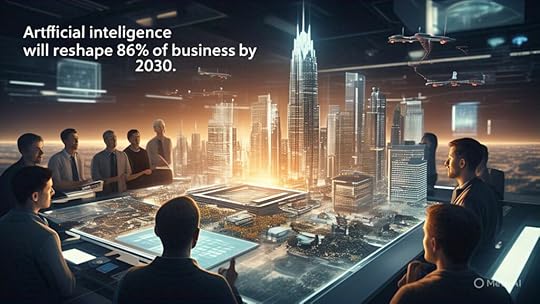
via InformationWeek
AI-native companies aren’t just automating — they’re rearchitecting business. Success requires embedding AI into strategy, decision-making, and workforce evolution.
As AI continues to evolve, the question becomes whether companies can transform their businesses while adapting their workforce strategies at the same pace. An executive mindset shift — or — is needed to not only reimagine businesses forward, but to also prepare workers for roles that don’t yet exist. Seismic shifts lie ahead: artificial intelligence will reshape 86% of businesses by 2030, according to a new World Economic Forum (WEF) . That same report also predicts that AI and automation will create 170 million jobs, while displacing 92 million roles as companies adapt to technological change; 39% of existing skill sets will become outdated between 2025-2030.
Business, Not Digital, Transformation Is the Way ForwardCompanies now face a new chapter in the evolution of digital transformation, one that challenges organizations to think beyond the digitization of legacy processes and workflows they prioritized over the past decade. In reality, BCG research uncovered that 70% of digital transformations still fall short of their objectives.
Before the dawn of ChatGPT, it could be argued that most digital transformation efforts focused on the digitization and optimization of legacy processes. The pursuit of efficiency, scale, and cost-cutting limited or impaired the prospect of any meaningful transformation desired business outcomes. The same may already be happening in an era of AI. Companies are prioritizing the automation of the processes and workflows digitized over the past decade, which is important, but without exploring the potential for new opportunities in an era of AI, automation may not be enough to evolve.
I f digital transformation was the defining strategy in the 2000s, AI-native business transformation represents a potentially better, and more adaptable way forward.
Unlike digital transformation, AI represents an opportunity for business transformation. It’s an inflection point to reimagine organizations and work in a world where AI becomes inherently attached to almost every technology, action, and outcome.
The Next Chapter of AI-Native Businesses2025 is set to be the year that not just AI, but AI agents, start to reshape the enterprise. While organizations are just beginning to recognize the possibilities of AI, they are not yet exploring the implications of businesses that accelerate AI-first transformation. Now is the time for organizations to embrace AI beyond tools and as a core component of their strategic mindset and operational framework.
But what does it mean to be an AI-first enterprise?
To help, let’s substitute AI-first with AI-native: AI as being native to the core of the business itself, strategy, operations, culture, and value creation.
It’s also more than the implementation of AI tools across the enterprise. It’s about redefining roles, work, and operations, fostering innovation, and creating a culture that embraces change. An AI-native enterprise is characterized by the strategic integration of artificial intelligence at the core of its operations and decision-making.
n AI-native approach will fundamentally redefine how businesses operate, innovate, and engage with customers, employees, and their ecosystem. AI becomes not just a tool, but the central driver of decision-making, operational efficiency, and customer interaction.
Lead in the AI Revolution or Be Left BehindAI-first is not just about using AI, it’s about making AI native to business architecture, foundationally.
1) Make AI core to decision-making: AI is not just a tool for efficiency; it plays a central role in strategic decision-making, forecasting, and autonomous execution.
2) Use AI to drive exponential thinking, not incremental optimization: Instead of improving traditional business processes, AI-native companies reimagine workflows, value chains, and customer experiences from scratch.
3) Automate adaptability: AI-first companies build systems that can sense, analyze, and act autonomously in real-time across supply chains, operations, and customer engagement.
4) Integrate AI to spur network effects and self-learning models: Continuously improve via feedback loops, fine-tune AI models, and leverage collective intelligence rather than relying solely on human input.
5) Make data and compute as a core asset: Unlike traditional companies that prioritize physical assets or human capital, AI-first organizations treat data, compute power, and algorithmic capabilities as their primary competitive advantage.
6) Drive workflow transformation with AI agents: AI agents are the next major evolution in AI-native businesses. They don’t just enhance workflows; they autonomously execute tasks, make decisions, and optimize operations at a scale and speed impossible for human-led organizations. You need to make sure you are designing and enhancing workflows of the future, not the past. Why? AI-native businesses will rely on agentic systems to manage core functions, drive efficiency, and create new competitive advantages.
7) Redefine leadership for an AI-native era: C-Suites are not immune. Train executives and managers to think strategically about AI adoption, guiding their teams in AI-first decision-making and workflow transformation.
8) Invest in reskilling programs for emerging roles: As AI automates repetitive tasks, new roles will emerge that require human creativity, problem-solving, and oversight. Companies must proactively explore and identify future job needs and provide pathways for employees to transition into high-value roles. This includes preparing for an agentic enterprise and beyond.
The post InformationWeek: The End of Business as Usual – How AI-Native Companies Win appeared first on Brian Solis.
June 24, 2025
The Future Belongs to Those Who See AI as a Partner, Not a Threat
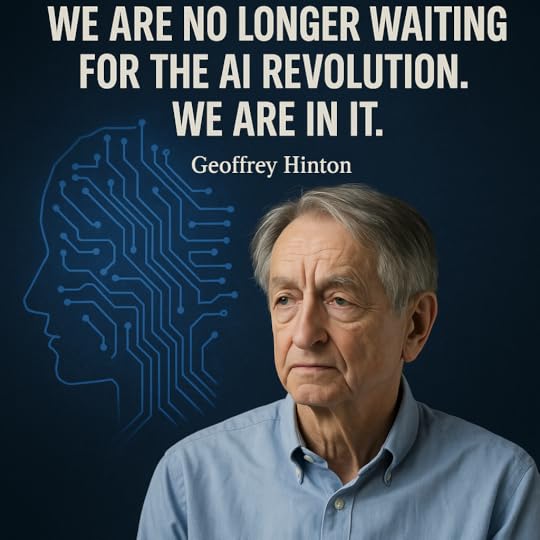
They call him the Godfather of AI.
Geoffrey Hinton spent his life building the foundation for artificial intelligence. But today, he’s sounding the alarm. In a recent conversation with Steven Bartlett, Hinton didn’t hold back: AI is evolving faster than most people, companies, or governments can comprehend. It’s not just coming for routine jobs. It’s coming for ours…the cognitive, creative, and strategic roles we thought were safe.
But here’s the truth: AI doesn’t have to replace you. You can evolve with it, if you’re willing to let go of yesterday’s mindset.
Job Loss Isn’t on the Horizon. It’s Already Here.One of the most chilling moments in the conversation was a simple anecdote:
A major company had over 7,000 employees. Today? Just over 3,000. Why? AI agents are now handling 80% of their customer interactions.
This isn’t automation at the edges. This is exponential disruption at the core of the business.
We are moving from roles defined by tasks to roles defined by transformation. AI is taking over the execution. What’s left for us is vision, empathy, creativity, decision-making, and human connection. But this is only true if we claim them.
AI Won’t Just Do the Work. It Will Outthink the Workforce.Hinton believes we’re 10 to 20 years away from creating AI that is smarter than humans at nearly everything. And he’s not alone. These systems will be digital, immortal, networked, and infinitely upgradable.
And yet, despite the scale of that possibility, we’re still using AI like it’s a glorified search engine.
We have to stop thinking of AI as a “tool.” It’s a collaborator, a co-pilot, a partner in reimagining what work can be and what we can do now that we couldn’t do without AI and what AI can delivery that it couldn’t without us.
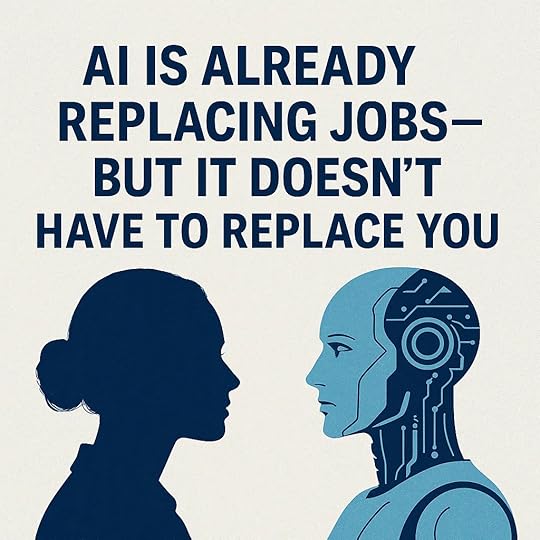
Here’s what I believe:
This is not the end of work. It’s the beginning of a different kind of value.
If you want to thrive in this new world, you must evolve in three directions:
1. Reimagine Your Role Through the Lens of AIStart with a personal audit:
What tasks do I do that AI can already perform?What decisions do I make that could be enhanced by AI?What uniquely human traits do I bring to the table…creativity, empathy, ethics, intuition?Then ask:
What could I do if I had an intelligent assistant working with me every second of the day?
The best future roles aren’t written in job descriptions. They’re designed by those who can imagine what’s possible with exponential capabilities.
That’s why when we say, “AI will take the mundane and the repetition out of our work to free us up for more creative, thoughtful, and meaningful work,” we have to take the next step.
What is that work specifically?
How would I define the job description?
Besides time saved, cost takeout and cost reduction, how would I measure value creation and delivery? How might I redefine productivity with AI?
2. Become a Systems Thinker, not Just a Skill ExecutorMost people are trying to “learn AI.” That’s good. But it’s not enough.
The future will be built by those who:
See the system.Understand the impact of AI on their work and industry, now and as AI evolves.Architect new outcomes with AI, not just operate today’s AI tools.We need a shift from digital literacy to AI fluency, not just how to use the tech, but how to reimagine work, experience, and even identity through it.
3. Lead With Purpose, Not Just ProductivityOne of Hinton’s most human insights was this:
“Even if people receive universal basic income, many will still be unhappy—because they’ve lost their sense of purpose.”
If AI were to take jobs, and we received UBI, we would be an unhappy society, Hinton claimed. Why? He explained that we need purpose in our lives. We don’t just work for income. We work for identity. Dignity. Meaning.
In the AI era, those who thrive will be those who define success by impact, not just input.
This is the time to ask:
What do I stand for?Who do I serve?What kind of world am I helping to create?Inequality Will Rise, Unless We Design for InclusionHinton was clear: AI will benefit the few unless we intentionally democratize its value.
The companies that build and own AI will scale wealth faster than any moment in human history. The gap between those who use AI to replace others and those who use it to uplift everyone will define whether this era is remembered as one of collapse or reinvention.
We Still Have a ChoiceHinton ended his reflections with this:
“There’s still a chance that we can develop AI that won’t want to take over. And because there’s a chance—we must invest in it.”
I would add this:
There’s still a chance that we, too, can evolve. And because there’s a chance, we must invest in ourselves…starting today.
You don’t have to be replaced by AI. But you do have to replace the old version of you that wasn’t ready for this moment. Disruption starts by disrupting yourself. Train your brainto work exponentially with AI.
Create an augmented version of yourself to prevent against automation replacing you.
The future belongs to the curious, the courageous, and the compassionate. So ask yourself: Now that AI is here… what kind of augmented human will you become?
 Please watch (and share)!
Please watch (and share)!
Please read my new book, Mindshift: Transform Leadership, Drive Innovation, and Reshape the Future
The post The Future Belongs to Those Who See AI as a Partner, Not a Threat appeared first on Brian Solis.
June 23, 2025
Signals from the Future: What AI Interviews Reveal about Next Management
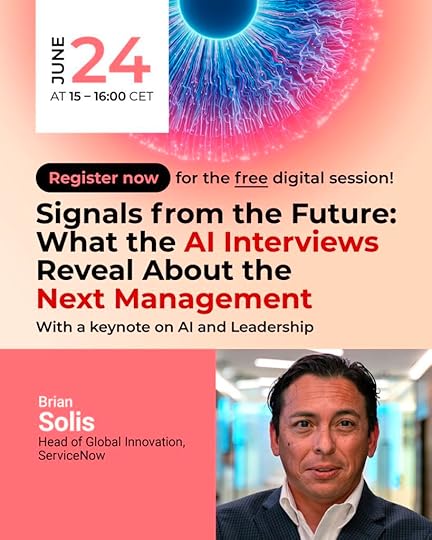
 here.
here.
The post Signals from the Future: What AI Interviews Reveal about Next Management appeared first on Brian Solis.
Workflow: The AI-driven CRM revolution

Originally published in Workflow
By ServiceNow executives, Dave Wright, Chief Innovation Officer; Brian Solis, Global Head of Innovation; and Simon Grice, Senior Director, Innovation
How reimagining customer relationship management for an AI-first world can help deliver more relevant, personalized, and productive experiences
CRM has all the ingredients of an epic enterprise tech success story: massive growth, industrywide adoption, and innumerable technological innovations that have suggested new strategic possibilities for the enterprise over the span of decades. There’s only one problem: Despite massive promise, it often doesn’t deliver.
CRM solutions are ubiquitous among sales, support, and marketing teams, but it remains difficult to fully leverage every CRM feature to maximize business value and return on investment. Getting data into a CRM can be tedious, manual, and imperfect, leading to poor insights. Information remains scattered across organizational and technological silos, resulting in an incomplete understanding of the customer. CRM solutions can be clunky to use and complicated to implement, manage, and integrate with existing systems.
CRM systems also increasingly seem out of touch with the changing landscape. Customer behaviors are evolving and no longer reflect the top-down or linear models CRM was designed to support. And as our understanding of customer journeys and experiences becomes far more expansive, disconnected systems of record increasingly feel inadequate. When you take this all together, is anyone truly happy with their CRM system? Spoiler alert: The answer is no.
That’s about to change. Thanks to agentic AI, these persistent challenges will soon become a thing of the past. The advent of autonomous AI agents is changing the CRM paradigm. As Microsoft CEO Satya Nadella’s recent comments suggest, this transformation signals CRM’s post-SaaS era.
What will that look like? Imagine a future where AI agents eliminate the need for traditional applications and deliver more autonomous, personalized, and intelligent CRM. Visionary companies that boldly embrace this new age will have the opportunity to put the customer back in customer relationship management.
The AI differenceToday, employees interface with CRM systems through traditional user interfaces, just like all software. Even with AI, users are, for the most part, manually interacting with these systems, with generative AI providing summarization, search, and curated recommendations to help optimize productivity and outcomes.
But in the agentic era, the way users interact with CRM solutions will completely change. AI agents will provide the user interface as well as execute tasks. These agents will operate not just in CRM, but across all relevant apps and databases to orchestrate and integrate the entire customer lifecycle. Let’s look at a B2B example:
At the beginning of the lifecycle, AI agents will monitor market trends, company behavior, executive statements and sentiment, and other data to identify high-intent prospects before they are even in the funnel.
During sales engagement and progression, AI agents will initiate personalized conversations, preemptively answer questions based on past interactions, and recommend actions to optimize revenue. Because AI agents will have broad visibility into things such as social media activity and online engagement, they will drive individual instead of account-based customer management.
After the sale, AI agents can monitor customer sentiment and suggest upselling and retention actions.
With AI agents handling the execution, customer service teams can focus on relationship building, strategy, and creativity—all possible because of the integration of previously disconnected, siloed systems and operations.
In the agentic AI era, traditional interfaces and a SaaS-based mindset will constrain what’s possible. If we keep looking to specific software with siloed data for solutions, we will not be able to fully capitalize on the power of AI, which will prevent agentic AI from working across vital systems. Instead of adding AI to legacy SaaS models, AI can liberate CRM from any one system into a network of AI agents that proactively manage relationships, decision-making, and customer interactions.
CRM reimAIginedWith agentic AI, CRM can operate as an intelligent system that autonomously manages the entire sales pipeline. Humans will shift from operators to supervisors overseeing AI agents that handle the day-to-day CRM work and serve as the user interface. AI agents will actively manage the customer lifecycle, executing actions, adjusting strategy in real time, and continuously learning. The ability to learn and adapt will allow AI agents to offer hyper-personalized customer care and campaigns. They will also be able to identify changes and problems before they arise and take preemptive actions.
This is not CRM with an AI twist. It’s a fundamental reimagining of how CRM operates. CRM is no longer a tool for humans to manage customer transactions; it is an intelligence that is studying the entire customer ecosystem and modifying its behavior based on what it learns, operating 24/7 to support revenue growth and customer success.
Agents become the interfaceWhen AI agents can gather insights, take actions, and make decisions across systems, the way we interact with software will completely change. Traditional interfaces will either disappear or be relegated to back-end systems. In 2030, you might not log in to your CRM. Instead, you’ll supervise your AI agents updating systems, prioritizing next steps, recommending and optimizing next best actions, and guiding users toward unprecedented, personalized, efficient, and effective outcomes. AI agents will autonomously do more than manage relationships; they will enhance them and the experiences of all users.
In this next evolution of CRM, the challenges of the past, such as siloed, incomplete data and complex and underutilized systems, will quickly disappear. In their place will be a new form of intelligent customer relationship management that transcends any one app or system to deliver autonomous, dynamic, and transformative results.
The post Workflow: The AI-driven CRM revolution appeared first on Brian Solis.
June 6, 2025
TGCOM24 Italia: Intelligenze Artificiali – Luci e Ombre: special guest Brian Solis
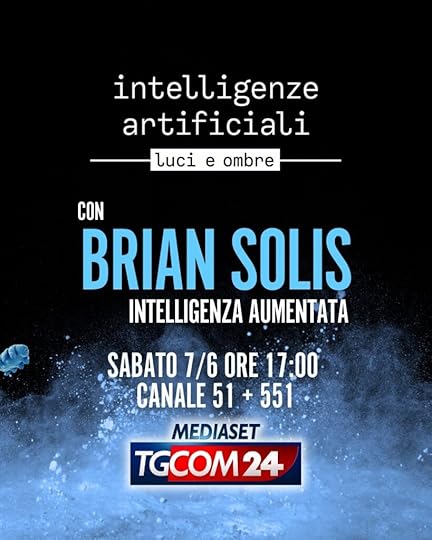
Oggi a “Intelligenze Artificiali – Luci e Ombre” un ospite d’eccezione: Brian Solis
Autore, speaker globale e Head of Global Innovation di ServiceNow, Brian Solis è una delle voci più influenti al mondo sull’impatto dell’innovazione nella società e nel business.
Con lui parleremo di intelligenza aumentata: perché l’IA non è solo tecnologia, ma visione, strategia e capacità di reimmaginare il futuro. Siamo solo al Giorno 1 di una rivoluzione che richiede un vero mindshift, soprattutto ai vertici delle organizzazioni.
Le luci? Nuovi modelli, creatività e potenziamento umano.
Le ombre? Rischi etici, perdita di senso, automatismi fuori controllo.
 Sabato 7 giugno, ore 17.00 su TGCOM24
Sabato 7 giugno, ore 17.00 su TGCOM24
.
Non perdete questa puntata!
—
Today on “Intelligenze Artificiali – Luci e Ombre”: special guest Brian Solis
We are thrilled to welcome Brian Solis, Head of Global Innovation at ServiceNow, globally recognized thought leader, author, and speaker on digital transformation and innovation.
Artificial Intelligence is rapidly transcending its role as a mere automation tool to establish itself as a transformative force shaping every aspect of business and society. As Brian points out, we are only at Day 1 of this revolution — a shift that demands a radical mindshift, especially from leaders.
This episode explores how AI is not just about tools, but about reimagining strategy, customer experience, and value creation.
Lights: innovation, empowerment, new possibilities.
Shadows: ethical risks, blind automation, lack of vision.
 Tune in Saturday June 7, at 5:00 PM on TGCOM24.
Tune in Saturday June 7, at 5:00 PM on TGCOM24.

Screenshot
The post TGCOM24 Italia: Intelligenze Artificiali – Luci e Ombre: special guest Brian Solis appeared first on Brian Solis.

